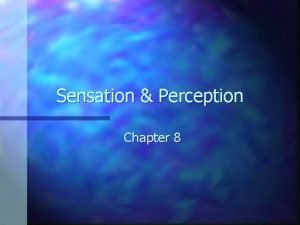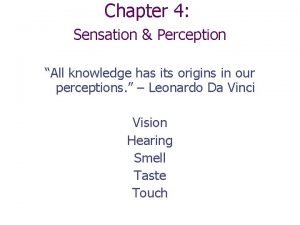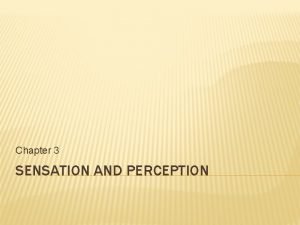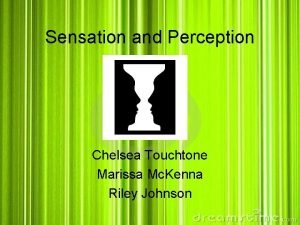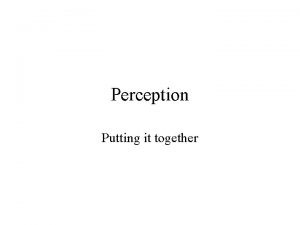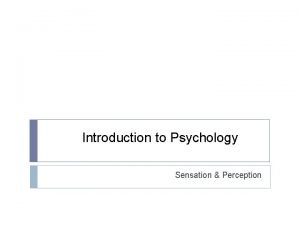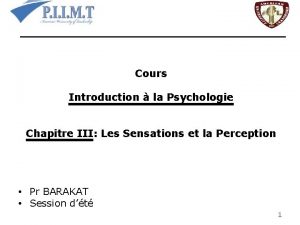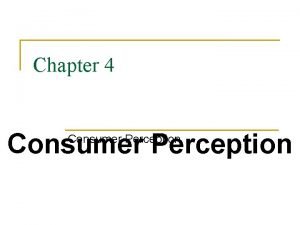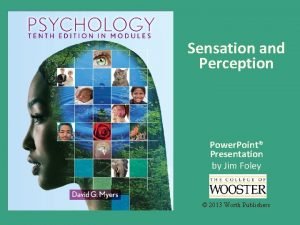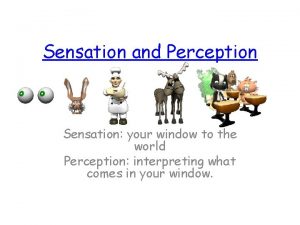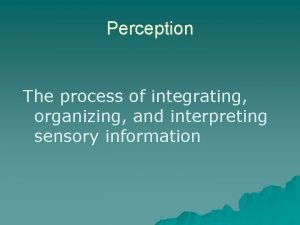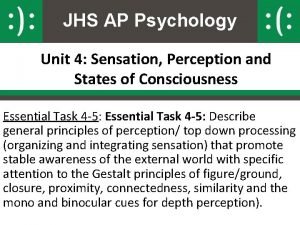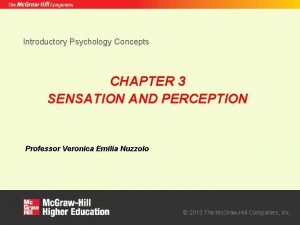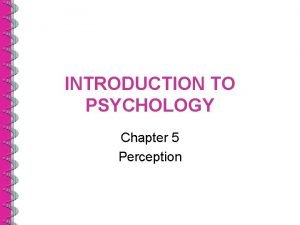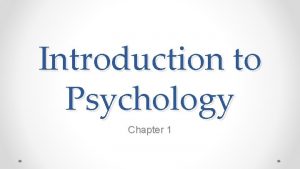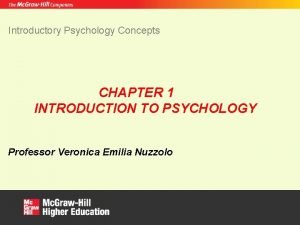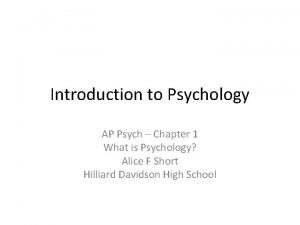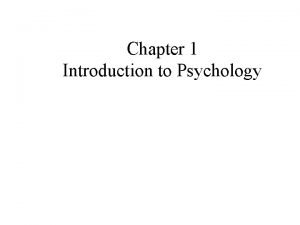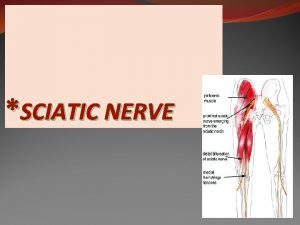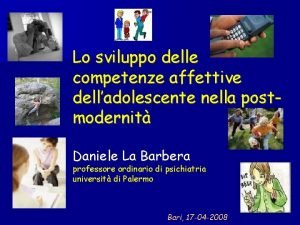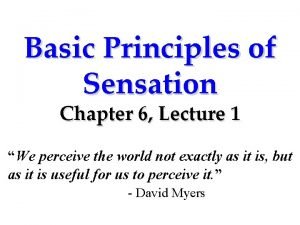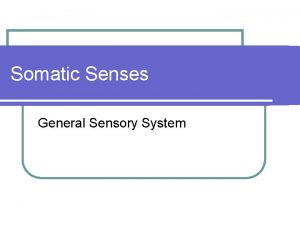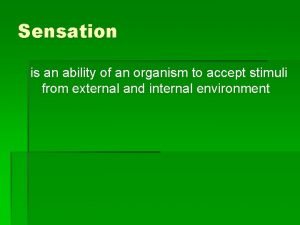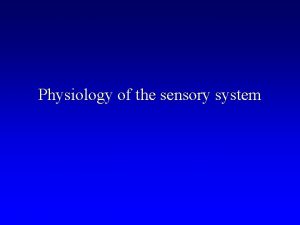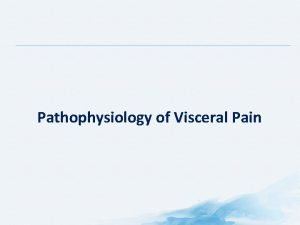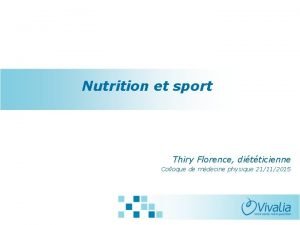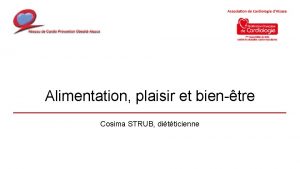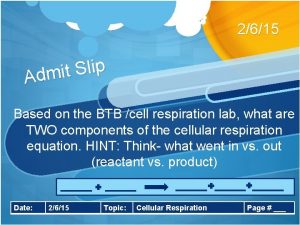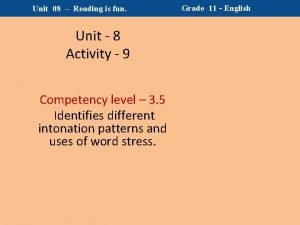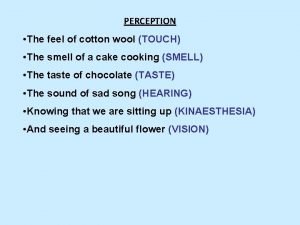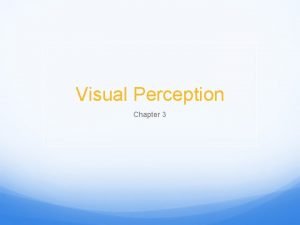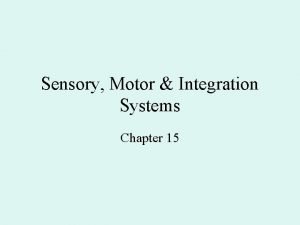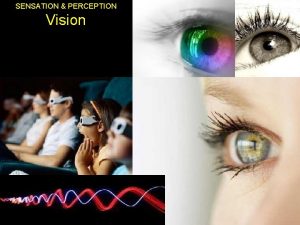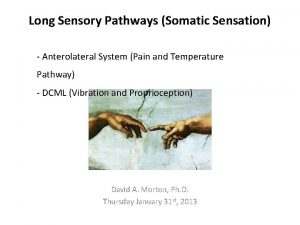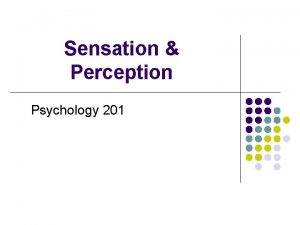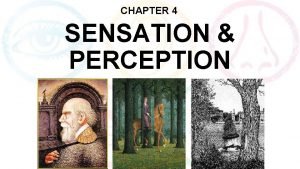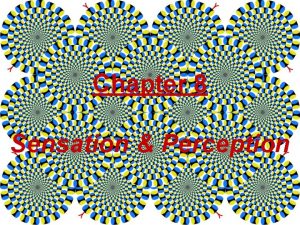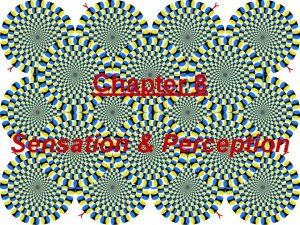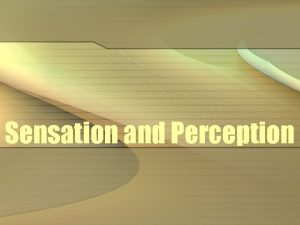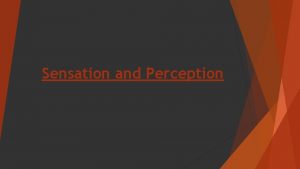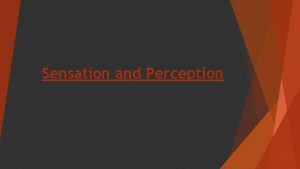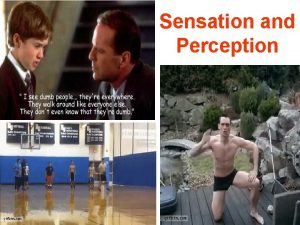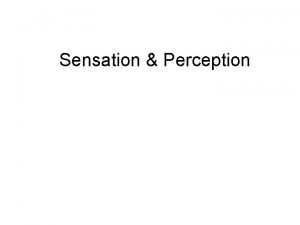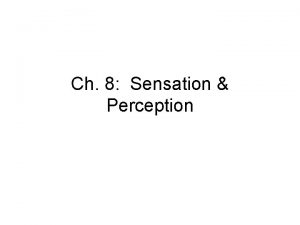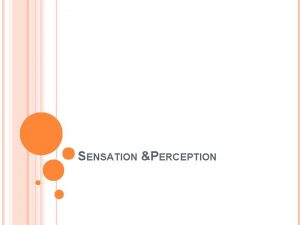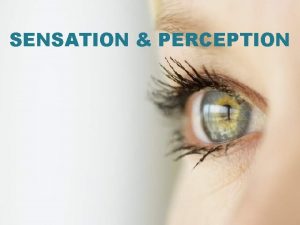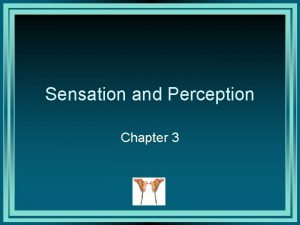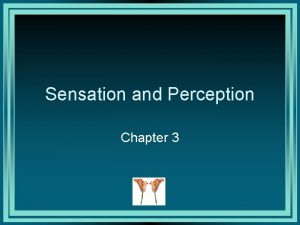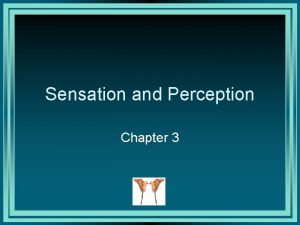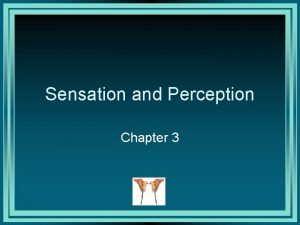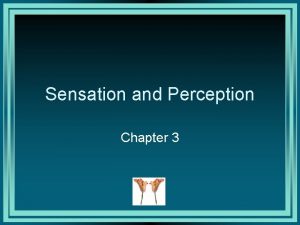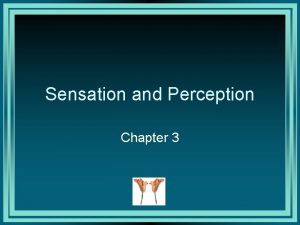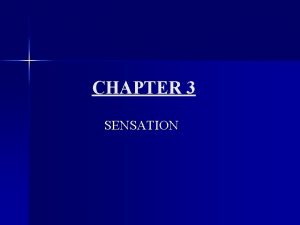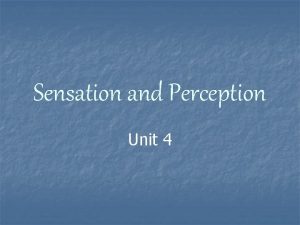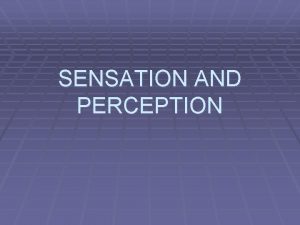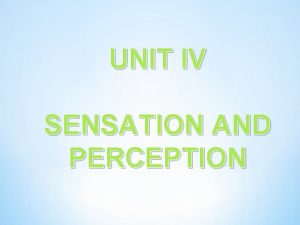Introduction to Psychology Sensation Perception Chapter 4 Journal




































![Touch, Vestibular, & Kinesthetic Senses � Touch (cutaneous [skin] senses) � Include touch, pressure, Touch, Vestibular, & Kinesthetic Senses � Touch (cutaneous [skin] senses) � Include touch, pressure,](https://slidetodoc.com/presentation_image_h/e4648677c07e9ca07f9a929c80c4baf8/image-37.jpg)









- Slides: 46

Introduction to Psychology Sensation & Perception

Chapter 4 Journal � If you had to give up one sense, what would it be and why? If you could enhance one sense, what would it be?

Chapter 4 Vocabulary 1. 2. 3. 4. 5. 6. 7. 8. 9. 10. 11. 12. 13. 14. 15. 16. 17. 18. 19. 20. 21. 22. 23. 24. 25. Psychophysics Sensation Perception Absolute threshold Just noticeable difference (JND) Sensory adaptation Nearsightedness Farsightedness Receptive field Primary visual cortex Prosopagnosia Capgras Delusion Color blindness Afterimage Reversible image Inattentional blindness Bottom-up processing Top-down processing Gestalt psychology Depth perception Visual Cliff Experiment Retinal disparity Perceptual constancy Gustatory system Olfactory cilia 1. Parts of the human ear (labeling & brief description) a. b. c. d. e. f. g. h. 1. Pina Auditory canal Tympanic membrane Hammer, anvil, & stirrup Semicircular canals Cochlea Auditory nerve Eustachian tube Parts of the human eye (labeling & brief description) a. b. c. d. e. f. g. h. i. j. k. l. Retina Lens Cornea Iris Pupil Fovea Optic disk Optic nerve Optic chiasm Optic tract Rods Cones

The Senses � Visual System � Auditory System � Olfactory System � Gustatory System � Vestibular System � Kinesthetic System � Touch � Other

Perceptual Organization � Perception � and Perspective https: //www. youtube. com/watch? v=h. CV 2 Ba 5 wrcs

Sensation v. Perception � Sensation: the stimulation of sensory receptors; neural signals from environmental stimuli (neural process) � The process of conversion between physical energy (i. e. light) into neural impulses is called transduction � Perception: the process of apprehending, recognizing, understanding, and learning of environmental stimuli (cognitive process)

Psychophysics � Psychophysics: the study of the relationship between physical stimuli and the behavior or cognitive experiences which they evoke � Absolute Threshold: the minimum amount of physical energy needed to produce a sensory experience (neural impulse) � Difference Threshold: The smallest physical difference between two stimuli that can still be recognized as a difference. � Sensory Adaptation (habituation): the diminishing responsiveness of sensory systems to prolonged stimulus input � Sensitization: prolonged sensory input increases or amplifies a response

Sensation & Perception: Vision

Sensation & Perception: Vision � Retina: the inside covering of the eyeball where images from the lens project � Full of neurons called photoreceptors � Rods: work best in low light; sees edges � Cones: works in brightness; sees color

Sensation & Perception: Vision

Sensation & Perception: Vision

Sensation & Perception: Vision � Glasses and contact lenses work by adjusting the focus of the image so it hits the retina properly

Sensation & Perception: Vision � Lasik corrects vision by reshaping the cornea so that light focuses correctly on the retina.

Sensation & Perception: Vision

Sensation & Perception: Vision

Sensation & Perception: Vision � Face perception is a special type of visual processing that involves individual recognition and emotional connection. � If the areas of the brain responsible for these abilities or the connection between areas is destroyed, patients can experience either Prosopagnosia or Capgras delusion

Sensation & Perception: Vision � Face � Perception Nuanced facial perception is typically associated with a place in the brain referred to as the Fusiform Face Area (FFA) � Located on the ventral surface of the temporal lobe � Damage to the FFA results in Prosopagnosia or “face blindness” � People are typically very good at recognizing faces……almost too good � Faces in weird places (i. e. toast)

Sensation & Perception: Vision

Sensation & Perception: Vision � Capgras Delusion � The pathway between visual information and emotion has been damaged, leading to the inability to connect images with feelings � Patients with capgras delusion can recognize objects, people, faces, and places but believe that they are identical “imposters” due to the lack of emotional connection � https: //www. youtube. com/watch? v=JQs. Qgo. PQ 24 s

Sensation & Perception: Vision � Depth Perception � The ability to view the world in three dimensions and to perceive distance � Occurs through processing the difference (Binocular Disparity) between the images seen by the right and left eyes � Depth perception and the fear of heights is acquired in infancy through experience � https: //www. youtube. com/watch? v=p 6 cq. N h. Hr. MJA

Sensation & Perception: Vision ¡ Color blindness: there are 3 types of cones; when a person lacks one or more types of cones they see the world differently � � Some animals have more kinds of cones and can see different wavelengths of color Qualia: is a term used in philosophy to refer to individual instances of subjective, conscious experience. � Is my red the same as your red? Do I taste the same as you do?

Sensation & Perception: Vision

Sensation & Perception: Vision Mantis Shrimp have 12 types of photoreceptors and can see much more of the light spectrum than humans (with our measly 3 photoreceptors). Mantis Shrimp must think we look really boring!

Sensation & Perception: Vision � Blindness https: //www. youtube. com/watch? v=ZDHJRCtv 0 WY � https: //www. youtube. com/watch? v=919 Gzqp. FDBk �

Optical Illusions � Reversible Image

Optical Illusions � Impossible Figures



Sensation & Perception: Auditory � Sound: The movement of air particles brought about by some source of vibration � This vibration is sensed by various structures within the ear Eardrum (Tympanic Membrane) � Tiny bones in the middle ear � � Hammer, � Anvil, & Stirrup Cochlea � Basilar membrane Hair cells

Sensation & Perception: Auditory

Sensation & Perception: Auditory � Sound localization: 2 ears allow organisms to locate the origin of sound in the environment � Relative timing � Relative intensity

Sensation & Perception: Olfaction


Sensation & Perception: Gustatory � Both olfactory and gustatory receptors are types of chemoreceptors. � � Smells are through distance chemoreceptors Tastes are through direct chemoreceptors � Taste buds on the tongue are bundles of chemoreceptors � Humans have approximately 10, 000 taste � Taste buds are replaced every 2 weeks buds � Taste buds are also located on the roof of the mouth and interior cheeks, just in less density. � About 80%-90% of what we perceive as taste is actually smell.


Sensation & Perception: Gustatory � Some substances “trick” different sensory neurons to fire resulting in weird effects � Menthol, a substance in mint, tricks the sensory neurons for cold to fire � Similarly, capsaicin, the chemical in spicy peppers, tricks the sensory neurons for warm/hot
![Touch Vestibular Kinesthetic Senses Touch cutaneous skin senses Include touch pressure Touch, Vestibular, & Kinesthetic Senses � Touch (cutaneous [skin] senses) � Include touch, pressure,](https://slidetodoc.com/presentation_image_h/e4648677c07e9ca07f9a929c80c4baf8/image-37.jpg)
Touch, Vestibular, & Kinesthetic Senses � Touch (cutaneous [skin] senses) � Include touch, pressure, temperature, and pain Sensitivity based on the density of nerve fibers and sensory cortex allocated to that area � Includes pressure and temperature � � Vestibular Senses your orientation in the world with respect to gravity � Information comes from the inner ear � People with vestibular issues may have vertigo � � Kinesthetic � Sensory feedback for motor activities

Sensation & Perception: Pain � Pain: body’s response to stimuli that cause or threaten to cause tissue damage; includes: Temperature � Mechanical � Chemical � � Pain is (somewhat) subjective and can be moderated by a variety of factors: Conflicting or distracting stimuli � Holding hands with a loved one <3 �


Intersensory Redundancy �Intersensory Redundancy occurs when multiple senses contribute to one synchronous experience � Intersensory redundancy recruits attention and promotes learning and memory � Infants can perceive events as synchronous even if they are offset considerably (700 ms); the window of synchrony narrows in adulthood (300 ms) � When sensory experiences are out-of-sync, attention learning becomes difficult and frustrating �Out of sync movie

Intersensory Redundancy � Problems can occur when there is conflicting stimulation from multiple senses � The Mc. Gurk Effect occurs when a sound does not match the facial movements of the person speaking The more “dominant” sense (in this case vision) wins out over the other (auditory), and perception of the stimuli changes � https: //www. youtube. com/watch? v=G-l. N 8 v. Wm 3 m 0 �

Perceptual Narrowing � Perceptual Narrowing is a sensory attunement process that helps organisms “hone in” on native stimuli, while ignoring irrelevant or improbable stimuli � Early in development, neurons are pruned from sensing environmentally rare stimuli and recruited for making nuanced distinctions for relevant stimuli � Perceptual narrowing occurs as soon as senses “come online” and works extremely quickly; most sensitivity to non-native stimuli is lost within the first year � Can inadvertently contribute to ethnocentrism and racism � Has implications for: � � Language processing Facial recognition

Perceptual Organization �Top-Down processing � Perception is guided by higher-level knowledge, experience, expectations, and motivations � Quick judgments based on previous experience, less taxing cognitively �Bottom-Up � Perception processing consists of the progression of recognizing and processing information of individual components of a stimuli and moving up to the perception of the whole � Takes more time to process each stimulus individually

Perceptual Constancy � The phenomenon in which physical objects are perceived as unvarying and consistent despite changes in their appearance or in the physical environment � Piaget (cognitive perspective) demonstrated how object permanence and perceptual constancy develops in childhood � https: //www. youtube. com/watch? v=gn. Arvc. Wa. H 6 I

Other Sensory Oddities � Anesthesia: Lack of sensation, lack of consciousness � Synesthesia: stimulation of one sensory or cognitive pathway leads to automatic, involuntary experiences in a second sensory process Numbers or letters might have color, sounds might have flavors, etc � Approximately 1% of the population has some form and degree of synethesia � https: //www. youtube. com/watch? v=BWGNWg. Bk 76 k �

 Copyright ?
Copyright ? Chapter 5 sensation and perception
Chapter 5 sensation and perception Chapter 3 sensation and perception
Chapter 3 sensation and perception Chapter 6 sensation and perception
Chapter 6 sensation and perception Vestibular sense vs kinesthesis
Vestibular sense vs kinesthesis Sensation perception
Sensation perception Chapter 4 sensation and perception
Chapter 4 sensation and perception What is sensation
What is sensation What are the gestalt principles of visual perception?
What are the gestalt principles of visual perception? Relative height ap psychology
Relative height ap psychology Sensation example
Sensation example Sensation and perception crossword puzzle
Sensation and perception crossword puzzle Sensation vs perception
Sensation vs perception Sensation and perception
Sensation and perception Exposé sur la sensation en psychologie
Exposé sur la sensation en psychologie Sensation and perception in marketing
Sensation and perception in marketing Perception vs sensation
Perception vs sensation Webers law
Webers law Sensation and perception
Sensation and perception Sensation vs perception
Sensation vs perception Sensation and perception uu
Sensation and perception uu Depth perception ap psychology
Depth perception ap psychology Perception meaning in psychology
Perception meaning in psychology Categorical perception psychology
Categorical perception psychology Monocular cues
Monocular cues Ap psychology social trap
Ap psychology social trap Introduction to psychology chapter 1
Introduction to psychology chapter 1 Introduction to psychology chapter 1
Introduction to psychology chapter 1 Introduction to psychology chapter 1
Introduction to psychology chapter 1 Introduction to psychology chapter 1
Introduction to psychology chapter 1 Sensation seeking
Sensation seeking Sciatic nerve and its branches
Sciatic nerve and its branches Sensation seeking significato
Sensation seeking significato 6 principles of sensation
6 principles of sensation Exteroceptors
Exteroceptors Types of sensation
Types of sensation Cortical sensation
Cortical sensation Viscerosomatic levels
Viscerosomatic levels Ditticienne base sur coute sensation
Ditticienne base sur coute sensation Ditticienne base sur coute sensation
Ditticienne base sur coute sensation What causes the burning sensation in your muscles
What causes the burning sensation in your muscles Reading 08
Reading 08 The touch the feel of cotton
The touch the feel of cotton Perception gestalt principles
Perception gestalt principles Sensation
Sensation Colour design: theories and applications
Colour design: theories and applications Dcml sensation
Dcml sensation





